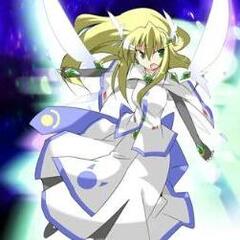Leaderboard
Popular Content
Showing content with the highest reputation on 11/03/22 in all areas
-

Helloooo I am Seceria
Templarseeker and 2 others reacted to Seceria for a topic
Helloooo! I am Seceria o.o I discovered Fuwanovel this November while writing the next episode in my visual novel for this year's nano. I lurked around here for a day, but come to think of it... My first visual novel was technically Katawa Shoujo. My friendo in intermediate school told me about it so I played it, which was... an experience. At the time I didn't know that it was a visual novel, or what visual novels were, or that there were more of them. A few years later I sign up on steam to play Team Fortress 2 with said friendo, and some more years later I discover visual novels on steam. My induction into visual novels was Fault milestone one, which was completely amazing and made me promptly go to read the second one and I am STILL waiting for the next one! Time passes and I consume ISLAND, Lucy the eternity she wished for, Newton and the Apple tree, World End Economica, Heart of the Woods, Doki Doki Literature Club... Then last year I stumble across RenPy. Armed with the Python knowledge gained from my last year of highschool and first year of university the time had come to see if I could do anything with it. Writing my own visual novel turned out to be a very fun time and so come to think of it, I've read more than one or two visualnovels in the past, and now... I've written one... So I've kinda already become a visualnovel fan somewhere along the way without realizing it... I have many hobbies - I play videogames (I still play TF2 to this day!), I play piano and compose piano music, I've written script fics and dabbled in a bit of roleplaying in the past, and I'm bad at chess. Let's add coding RenPy and visual novels on top of that, shall we!? Nice to meet you all!3 points -
祝姫 It has some of Ryuukishi's trademark writing: the unreliable protagonist, the sudden shifts in mood, the blurring of reality and fantasy, but without any of his themes. It's a rather bland and boring horror game, but shows some of his spark from time to time. So far, it's a rather standard B flick horror movie. They just try and shove as many disgusting things at you as possible. They don't even show the worst of it explicitly, which makes it a rather half-assed game. I feel like the art doesn't really contribute anything to Ryuukishi's writing. If there is any good thing that came from this, the voice acting is top notch. Ryuukishi really knows how to go back to being a kid and write SOL the way a kid would think, but the problem is it doesn't fit the story this time. Overall, a rather mediocre experience.2 points
-
[OPEN] Mystery/Drama VN Volunteers!
yeju reacted to keanexists for a topic
Hello, I hope whoever reading this is having a great day. Seeking volunteers for our visual novel project, we have decided to turn to these forums to see if there is a possibility of finding new teammates. A brief explanation of the project: it is a dramatic mystery following an aspiring private investigator in their Senior year of an American high school, where they take on the task of exploring rumors around the school as a stepping stone to their career. They meet the subjects of three rumors, all of them tying into something much greater than your typical school drama. Here are the roles that are currently needed for this project: + Cityscape/Scenery Artists + Music Composers + Script Editors/Proofreaders If you have made it this far, thank you. Please let us know if any of this catches your attention, and have a good rest of your day or night.1 point -
Hello everybody, my name is Jacob. I'm the head writer and programmer of the OELVN Siren's Call. It took about four years, but we recently completed the project. I'm pretty new to fuwanovel, but can see there's a lot of creatives floating around here that are either trying to make their own VN or are at least interested in the process of what it takes to make one. Because it's such a daunting process (at least for me it was), I want to do what I can to answer any nagging fears or inquires the community has about what it takes to really get to the point where you can finish making one of these things. Lately, I feel like my experiences have just kind of been rotting inside my own head, so I want to use what I've learned for something other than just working on my second project. If you're making a VN and feel lost/confused about what to do next, how to stay motivated, or even if you wanna know more about what the process is like, then let's talk about it! Be it programming, asset creation, marketing, story-boarding, expectations,...let's get a conversation going about what it's really like to make one of these!1 point
-
Just yesterday I played a bit of Mother Matron, which is some funky horror denpa game I found where you are living in some isolated world where rats rule the sewers and there are scraps of metal falling from the sky, killing people. It's definitely horror and it got me once or twice scared. What adds to the positives is that the game has some solid voice acting despite being a totally free game. And today I started playing FAKKUs newest release, St. Yariman's Little Black Book which is an Orcsoft ZOMBIE Nukige with my beloved gyarus. There are four girls in total and they all have vastly different personalities, that are still quite one-note. I liked Mana's part the most because I like that cutesy e-girl idol star personality she has. The dialogue is quite good and the localization is also not half bad. I noticed at some point however they omitted mentions of Mesugaki, but at another part of the game they translated that into "bratty little kid" so my suspicions of forced censorship can be laid aside. It's a decent pick up for slutty gyaru nukige and I'm happy that FAKKU localized this. Have some examples of funny dialogue:1 point
-

The Common Route – An Anatomy of Visual Novels
Seceria reacted to Pallas_Raven for a blog entry
This is a condensed version of the full article which can be found on my Main Blog Here. In The Beginning If there is one structural element which is used by most visual novels it is the Common Route. This linear opening section contains the choices which decide the route you will be sent on as well as providing world and character building setup so that the routes can focus on their specific hero/heroine. They are so ubiquitous with visual novels that even those who are not familiar with medium still associate them with the Common Route. Why has such a distinctive structural ingredient become so ingrained into the mind of visual novel developers? Other games which emphasise choice do not share this aspect and instead opt to use different structures, such as the actions and consequences approach of Telltale games or the Mass Effect series. Visual novels alone champion the Common Route. This article will dive into the technical implementation of the Common Route and find out both why it is so widely used as well as its strengths and weaknesses. The Backbone of a Visual Novel - The Pros and Cons When it comes to implementing a common route into a visual novel there are many advantages but also trade offs to doing so. This section will cover some of the most prominent examples from each end of the argument and why you might consider having one in your game. The strengths of the Common Route revolve around its function as the foundational pillar from which all other routes and elements can build on. The most prominent strength is the fact that the Common Route often does the heavy lifting when it comes to establishing the world and characters of the story. This means that the main routes do not have to get bogged down with exposition and can focus purely on their specific characters, themes and plots. The Common Route ensures a level of understanding on the part of the player which the writer can rely upon as a basis for what they can subsequently create. This prevents pacing problems in the main routes where the majority of important and memorable events happen and makes sure that the player is left with a positive impression rather than becoming bored with in-universe explanations. In a similar vein, the Common Route allows for the establishing of a malleable status quo and sets the tone for the rest of the game. This is important as the routes which diverge off the Common Route are likely to have distinctly different themes and plots which might contradict one another if placed side by side. By building a flexible foundation in the Common Route a visual novel can avoid possible contradictions through allowing for a variety of outcomes to be reasonable extrapolations from that base situation. Working to complement this is how it establishes the tone of the game. While this might be subverted later on, it sets expectations which can be built off and provides a sense of consistency for the game as a whole. On a more practical level the Common Route is a useful tool to control the scope of a visual novel. There is obviously the contraction into a single section of the world building and character set up as mentioned before, but on top of that it is an easy area to insert in events from other routes which were cut for pacing reasons and need a new location to play out. In addition, it is a section which the player will repeatedly traverse through meaning it allows for a padding of the play time if you need to control how fast the player consumes the game. Broadly speaking the weaknesses of the Common Route come down to the bad writing habits it can cause in some writers if they are not careful with its implementation. We often see this in the poor pacing which can be found in many Common Routes. The desire to put all the exposition and character set up in the Common Route can lead to an over-saturation of this content leading to a bloated and slow feeling pace and as a result it can struggle to hold the players attention. The Common Route should never outstay its welcome, it is not the star of the show just the warm up act. As such knowing what length of Common Route is appropriate for your visual novel is a key skill for the game’s overall pacing. The Foundation of Many Faces - Types of Common Route In order to accommodate the needs of the countless different visual novel in existence, the Common Route has been adapted to suit their differing purposes. In this section, some of the most common types of Common Route will be covered to see why each one is used. The most standard of all Common Routes is the straight line. However, even this simple structure has some important variations to it in the form of whether it has early or late branching routes. This decision changes the dynamic of the player's interaction with game. Common Routes which start branching earlier generally have a faster pacing and a shorter length as the routes rapidly take centre stage. This type is generally chosen when the visual novel either wants to quickly split the plot into distinct sections with heavily divergent events or wants to focus in on specific characters rather than there interactions with one another. Tsukihime is a strong example of the first category, it has an opening Common Route which introduces the characters in a basic fashion before splitting into the Near Side and Far Side routes which focus on different aspects of the plot and the world. The second category is best exemplified by Katawa Shoujo which does not dwell on its Common Route and instead diving into the routes quickly so that the focus in placed solely on the characters and their struggles. These examples of early branching Common Routes reveal the strength of using one, the ability to emphasise a particular aspect of the narrative by shifting the focus into it rather than dwelling on the Common Route itself. For visual novels with a focus on plot or characters as its core appeal having an early branching Common Route allows them to keep the momentum up while playing into their strengths. The last type of Common Route which will be covered here is the Ladder Structure. Of the Common Route types this is by far the least used by developers and this is due to the fact it requires them give up a lot of the non-linear aspect of visual novels in exchange for its strengths. In a game with a Ladder Structure the Common Route takes on the role of containing the main plot which would normally be contained in the routes and forms the majority of the play time. Character routes generally diverge off the Common Route at set intervals such as near the end of chapters (hence it forms a kind of ladder), though they are generally optional and only expand on the Common Route rather than containing key plot points. The only exception to this is the final route which comes straight off the end of the Common Route and is almost an extension of it to conclude the story. The most iconic example of the Ladder Structure is Steins Gate which follows the above formula to a fault with each heroine getting a small route but with the focus clearly being on the Common Route and its push towards a narrative conclusion. This works for Steins Gate because of its thriller writing style which keeps the pace up throughout its duration and the side routes act as a sort of breather from the main plot and it results in a more even experience than a standard route based game. The Ladder Structure works best for visual novels which want to emphasise their more linear stories but still want to have some routes to keep the reader engaged through choices. It trades the benefits of a more non-linear structure for a tighter narrative experience. Why are common routes so common? When looking at visual novels as a whole, this is a natural question to ask given the frequency of Common Routes. The obvious answer is to point to the benefits which have been listed above as the primary motivating factor for their inclusion and this is in part true since Common Routes provide what visual novels need in terms of structure. However, there is another factor at play, expectations. Common Routes have become such a ubiquitous part of the medium that the audience expects one in every visual novel, whether the game needs it or not. This is especially true for romance based visual novels where the player's choice of heroine/hero is so important that not having a Common Route might anger some players since it betrays their expectations. That is not to say that there are no visual novels without Common Routes, we can find plenty of examples from the simultaneous story sections of games like Wonderful Everyday and Zero Time Dilemma to the recent trend for episodic games like Phantom Trigger and 9 nine. Instead this perception of the necessity is just a limit on the creativity of visual novels and one which needs to be broken if we are to see more interesting and experimental games in the medium. The Best Fit For All? Common Routes are at the heart of visual novel design as a pillar of support for the non-linear aspects brought about by the presence of routes and it provides these games a flexible anchor they can build around. The exact structure and use of a Common Route has mutated into different forms over time to fit the needs of each story, but at their heart they focus on marrying the linear and non-linear. Despite how useful they can be, you should never become too attached to them and instead ask if they are what best fits the story you want to tell. Be inventive with your Common Routes and maybe you will create a new type Common Route which revolutionise the world of visual novels. After all there is nothing common about a good Common Route.1 point -

The Common Route – An Anatomy of Visual Novels
Pallas_Raven reacted to littleshogun for a blog entry
Speaking of common route, well some authors may have more creative juice when they did make it so much that it's the peak of their VNs and caused the routes to be much more underwhelming compared to the common route. The examples of one of those is Bokuten, at least from what I can see. Bokuten itself actually have quite unique common route, with the structure basically like Yurirei that'll tell several stories about the couples while the MC going to get the development in the characters route (Supposedly), although too bad that the twist is pretty much send the mixed signal to on how good the common route is (It's also not help that one of the route is probably the time when the author suffer some breakdown to a degree). In the end, well I suppose when it come to common route it depend on how the author wrote it, whether it'll be good or not. PS - Here's the video that Ange record in regard of his best common route, and it might be a good video to watch if you have time to research about good common route. By the way one of the example in the video is the aforementioned Bokuten. Whether you'll agree with those examples are up to you.1 point -

Hi my name is march
I-heart-rena reacted to littleshogun for a topic
Welcome to Fuwanovel, and I have no problem if you're like Rena from Higurashi here (I still can say that Gou Sotsu duology is quite problematic, but that's another story). I hope that you'll enjoy yourself here.1 point -
Recently I've finished Ayakashi. I've actually heard of the game back in 2010 but only got around to it this year. It was really enjoyable, it's been a long time since I've played a game like it - the writing is to the point and easy to read, but it draws you into the world. The story about the protagonists fighting other people with parasitic supernatural beings (a lot like Jojo stands) is used to deliver an overarching theme of getting over the loss of your close friends and lovers. There are a lot of bonus routes that show different perspectives and it's cool how you gradually figure out the setting. In particular I liked the relationship Maekawa has with the villain. The highly dynamic scenes with a lot of CG changes (the CG collection is huge!) were also great and gave it a a shonen manga feeling. And of on top of all it the humor was good, Anzu's route in particular had some hilarious moments. It's a shame that apricot/crossnet never tried publishing it overseas, I think it would have been decently popular. Next I've started Maple Colors, their previous game. There's a massive cast, and a lot of them are very memorable. The main heroine in particular, Mirai. Some of the minigames (it has fast-paced minigames you have to beat to recruit some people) are crazy hard. I've played about 10 hours, but I ran into some technical problems, sometimes when I start the game the fps is either low or very high. Not sure what causes it This godforsaken minigame right here:1 point
-
Hear ye, hear ye -- In case you hadn't noticed, Fuwanovel has a blog app which includes two dev-exclusive blogs (Updates & Recruitment) to help you out. The idea is that you post in one of these blogs, and it's broadcast to all the sites in the Fuwa network. Project Updates Feed (blog link) (rss) -- this is for non-trivial updates like introductions when your project first joins the Fuwa Ongoing Projects board, demo releases, events, announcements, final releases etc. You should also be posting in your project thread (i.e. small or check-in updates shouldn't be posted here) Help Wanted/Recruitment Feed (blog link) (rss) -- to be used as necessary. You can re-post job openings once every 3 days if you've having trouble finding help These two blogs are being integrated into the forums index, the Fuwazette blog, and the Reviews Hub, but in order to post in them you have to get a special "Project Manager" permission set from an admin. One person from each project will have free posting rights to both blogs (you pick who it'll be). The Developer role will give you access to post on the Dev update feed. Permissions to Moderate your own thread (lock/hide etc.) brag with a badge as being part of the community the title you work on is guaranteed to added to frontpage once it releases. *You might have get requested by emi to give additional info or images of your title once it releases. To get blog posting access you should have a project on this OP board, then please PM Emi the following: Who you want to get the permissions and what their relationship is to the project (team lead, PR, etc.) The name of your project The url of your project thread in the fuwa forums After getting permissions: How to make and format a post: Click "Add Entry" on the blog page (Updates) (Recruitment) Write and format the post just as you would making a post on the forums We highly, highly suggest you use at least one image in your post for us to use in the Wordpress featured image function. PLEASE NOTE: The first image in the blog post will be its "featured image" (the image used to represent the post on the other Fuwa sites), so make sure it looks nice, is appropriate (no nudity, etc.), and is of decent size (preferably larger than 300x200px). ^ If you choose to include an image, please do everybody a favor and compress it before using it It may take up to an hour for the post to appear on all the Fuwa sites, but if a post isn't appearing in <=60 minutes, contact an admin I'm going to do my best to make this a useful tool for you guys, and please don't hesitate to get back to the staff or Emi with feedback/input.1 point


.thumb.png.77c6a4b51f0f253de8f67a004dc1189c.png)




